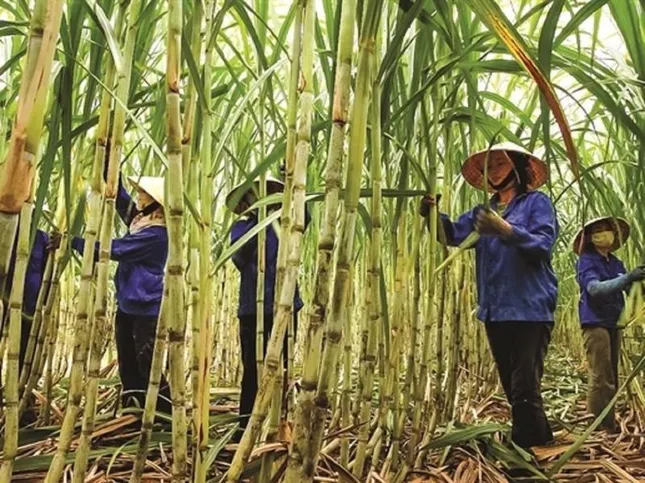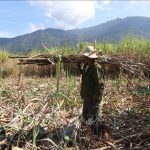According to the Vietnam Sugar and Sugarcane Association (VSSA), as of the end of May, sugar mills across the country had basically completed the crushing season with a total output of over 1.2 million tons of sugar. However, domestic sugar consumption faced significant challenges, resulting in inventory levels surpassing 70% of total production – a record high.
Mr. Nguyen Van Loc, Chairman of VSSA, stated: “This is an unprecedented inventory level in the industry’s history. Many mills ran out of storage space and were forced to sell at a loss to recoup funds and pay farmers, but even then, there were no buyers.”

By the end of May, sugar mills nationwide had completed the 2024/25 crushing season, producing over 1.2 million tons of sugar from 12.68 million tons of sugarcane raw material. Illustrative image: IT.
According to VSSA’s records, sugar prices in Hanoi at the end of May were at a low level, with refined sugar selling for 18,000-18,400 VND/kg, refined sugar at 19,200-20,000 VND/kg, and golden sugar at 18,000 VND/kg.
The global sugar market is also going through a cycle of significant price declines. According to the International Sugar Organization (ISO), the average price of raw sugar in May fell to 17.69 cents/pound – the lowest in three years. White sugar prices also dropped sharply to 487.15 USD/ton, significantly lower than in March and April.
This negative development stems partly from ample supply in major exporting countries such as Brazil, India, and Thailand. Additionally, the US’s new tax policies in the region have further depressed sugar prices in the Americas, with ripple effects on the global market.
According to Mr. Loc, Vietnamese sugar prices have been at their lowest in the region since the beginning of the year. The main reason is the abundant supply from the remaining inventory of the 2023-2024 crushing season and the new output from the 2024-2025 season.
The pressure from excess supply has led to a significant drop in prices, leaving many domestic sugar mills in a dilemma. Many businesses have been forced to sell below production costs to repay debts to farmers, but they still struggle to find buyers.
If the supply glut and falling prices are the first wave of this “storm,” then the rise of high-fructose corn syrup (HFCS) and the rampant smuggling of sugar across the southwestern border are the silent but persistent underlying waves dragging the sugar industry’s recovery.
According to VSSA, sugar smuggling across the southwestern border into Vietnam remains complex, despite the government’s recent strong directives and instructions.
Mr. Loc affirmed: “Sugar with unclear origins continues to flood the market.”
Simultaneously, HFCS, mainly imported from China and some ASEAN countries, is increasingly used in the food processing industry due to its low cost and high substitutability.
According to the General Department of Customs, the volume of HFCS imported in May remained unchanged from the previous year. Still, its consumption rate in the domestic market has accelerated, rapidly replacing sugar and severely impacting the industry’s value chain.
The Sweet Success of Vietnam’s Sugarcane Industry: Climbing to the Top
Since 2021, Vietnam’s domestic sugar industry has been witnessing a resurgence, following the implementation of trade defense measures on imported sugarcane products. Between 2011 and 2021, sugarcane fields witnessed a decline from 283,000 hectares in the 2011/12 crop year to just 146,938 hectares in the 2021/22 crop year. However, in the last three years, there has been a notable turnaround, with sugarcane fields now covering nearly 175,000 hectares, indicating a sweet revival for the industry.
The Markets on August 15: Oil, Gold Down Over 1%, Grains on the Rise
The global energy landscape witnessed a shift on August 14th, with oil prices dipping by over 1%. This development was triggered by an unexpected rise in US crude oil inventories, casting a shadow over the market and prompting a cautious stance among investors. The release of the US Consumer Price Index for July, which met expectations, further added to the cautious sentiment, resulting in a 1% decline in gold prices as investors weighed the impact of steady inflation on the demand for safe-haven assets. The ripple effects of these events were also felt in the iron ore market, with prices plunging to their lowest levels in over a year, reflecting the delicate balance between supply and demand dynamics in the face of shifting economic tides.
Shrinking sugarcane areas in Khanh Hoa province
The cultivation of sugarcane in Ninh Hoa town, Khanh Hoa province, has long been an integral part of the local agricultural economy. However, like many other areas, sugarcane farming here is facing challenges as farmers are gradually shifting to other crops, resulting in a shrinking sugarcane cultivation area.


















